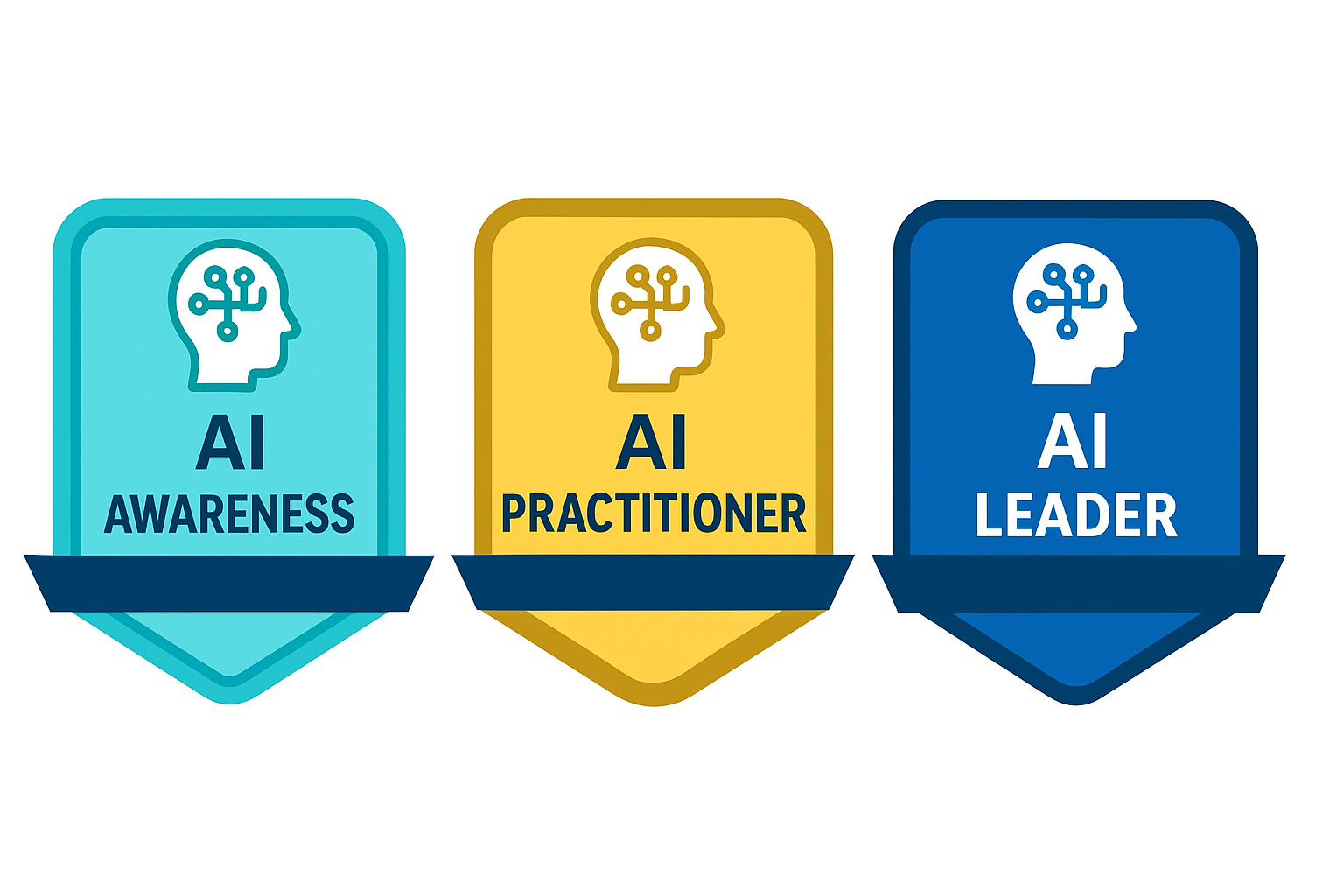
AI tools (text, image, audio, and video generators) are now ubiquitous. Schools need a pragmatic, sustainable way to help teachers (1) recognize AI-generated student work, (2) document and respond to misuse fairly, and (3) teach students how to use AI responsibly and safely. Microlearning + digital badges is an excellent fit: bite-sized learning that respects teachers’ time, evidence-backed retention benefits, and portable credentials that document competence for transcripts, portfolios, and PD credit.
Recent systematic reviews and empirical studies show microlearning improves knowledge retention and learning outcomes when well-designed, and micro-credentials/digital badges are an increasingly adopted model for teacher professional learning.
Program overview
A year-long blended PD program made of:
10 microcourses (10–12 total hours of short, focused modules you complete asynchronously; each modular microcourse = ~1 hour of teacher work split into 3–6 bite-sized lessons).
Monthly faculty micro-presentations — 15 minutes at a staff meeting (10 months = 2.5 hours total).
Artifacts & portfolio: practical evidence of transfer (lesson plan adaptation, rubric, student-facing handout, classroom demo video or reflection).
Badge pathway & capstone: earn 3 tiered badges (Awareness, Practitioner, Leader) culminating in a portfolio capstone validated by the Director of EdTech.
Estimated PD credit: program qualifies for ~20 PD hours (10 asynchronous + 2.5 synchronous + 7.5 for portfolio/capstone and guided practice). Local districts / state authorities set exact CEU/clock-hour conversion; many guidelines treat 10 contact hours ≈ 1 CEU, and NEA/district guidance recommends micro-credentials be at least ~10 hours of work each. HeadStart.gov
Learning outcomes (by badge)
Badge 1 — AI Awareness (Intro) (≈ 3–4 microhours)
Teachers can list common types of generative AI (text, image, audio, video).
Teachers can recognize red flags for AI text/images and apply a short checklist to suspicious work.
Badge 2 — AI Classroom Practitioner (Practice) (≈ 6–8 microhours + artifacts)
Teachers can use simple detection strategies, design equitable assessment alternatives, and write/communicate classroom AI policies with students and families.
Teachers submit a classroom artifact (syllabus language, assignment redesign, rubric) for review.
Badge 3 — AI Leader (Implementation & Coaching) (≈ 8–10 hours + capstone)
Teachers lead a short unit teaching students responsible AI use; coach at least one colleague; submit a portfolio with student-facing lessons and a reflection.
Director of EdTech verifies and issues the Leader badge.
Microcourse modules
What is generative AI? (10–15 min) — definitions, examples, quick demo.
How to spot AI-written text (15–20 min) — red flags, prompt fingerprints, simple digital checks.
Recognizing AI images & deepfakes (15–20 min) — visual cues, metadata basics.
AI audio & video: synthetic voices & face swaps (15–20 min).
Assessment design to reduce misuse (20 min) — prompts, process evidence, oral defenses.
Student conversations about AI: language & restorative approaches (15 min).
Classroom policies & fair consequences (20 min) — progressive discipline & academic integrity.
Teaching students to use AI responsibly (30 min) — lesson template + student badge.
Privacy, data, and school/district policy (15 min) — FERPA-adjacent concerns and vendor checklists.
Coaching & leading AI PD (portfolio tasks + rubric) — final practices and evidence.
Each micro-module includes: a 5–8 min interactive video, a 5–10 min interactive quiz or reflection, a task (artifact), and a short knowledge check. Use spaced reminders/notifications and short spaced-rep quizzes to improve retention.
Monthly 15-minute faculty session topics (10-min talk + 5-min Q&A)
Month 1: Why AI literacy matters — quick demos and one takeaway for every teacher.
Month 2: Red flags for AI text — show two student examples.
Month 3: Alternatives to high-stakes essays — process journals, drafts, digital notebooks.
Month 4: Family communication templates — sample email & FAQ.
Month 5: Assessing multimodal AI (images/video) — classroom protocols.
Month 6: Teaching students to cite AI use — classroom practice.
Month 7: Student privacy & vendor vetting checklist.
Month 8: Using AI tools to accelerate teacher work (lesson planning ethically).
Month 9: Success stories — teacher showcases and evidence.
Month 10: Portfolio clinic — finalize artifacts and badges.
Software & tools
These tools are affordable, easy to author, support micro-lessons, and integrate open badges or xAPI for evidence.
Authoring & microlearning platforms
EdApp / SC Training (microlearning-first) — mobile-friendly microlearning LMS with templates, spaced repetition, and rapid authoring . Great for bite-sized lessons. SafetyCulture Training
TalentLMS — simple LMS with microlearning and SCORM/xAPI support for districts wanting more LMS features. e-learningpartners.com
Moodle (plus H5P) — open-source LMS that pairs with H5P for interactive microcontent (if a district prefers self-hosted). H5P authoring gives interactive videos, branching scenarios, and quizzes that embed in Moodle. H5P
Badge & credential platforms
Badgr — Open Badge issuing and backpacking; integrates well with Canvas/Moodle and supports portable Open Badges. Ideal for K–12 and free tiers exist. badgr.com
Credly — enterprise-grade credentialing & verification if you want public professional recognition and analytics. Good for district-level, externally verifiable badges. info.credly.com
Digital Promise Badge Engine — an example of an education-focused badge engine for issuing micro-credentials in K–12 contexts. Digital Promise
Interactivity & artifact collection
H5P (interactive content you can embed into Moodle/Canvas).
Google Forms / Microsoft Forms for short micro-checks and artifact uploads.
Video collection via simple phone uploads to your LMS for teacher demonstrations.
Optional detection & demonstration tools (for teacher awareness, not perfect detectors)
Turnitin/Rubric tools (if available) to check for textual similarity.
Free AI detection demos and browser extensions exist — use as discussion starters and teach limitations (no detector is 100% reliable).
How many PD hours & how to document them
Each microcourse is ~1 hour of teacher-facing time (3–6 microlessons of 10–20 minutes each). NEA and micro-credential guidance recommend micro-credentials be substantial (often ~10 hours of work) if they are to count toward advancement or pay. A conservative, district-friendly approach: issue each badge only after ~8–10 hours of demonstrated work (microlearning + artifacts + short synchronous activities). National Education Association
Example PD credit mapping (district-friendly)
AI Awareness badge — 3 hours → 0.3 CEU (or local clock hours as district decides)
AI Practitioner badge — 8 hours → 0.8 CEU
AI Leader badge + capstone — 12 hours → 1.2 CEU
Total program ≈ 23 PD hours (can be rounded or aligned to local state clock-hour rules). Always pre-approve with your district PD office to ensure state clock-hour acceptance.
Research & evidence
Systematic review of microlearning showing positive effects on learning outcomes and themes for best practice. ScienceDirect
Empirical study: microlearning improved learning and self-efficacy among health profession students (shows cross-domain transferability and design principles). PMC
Systematic research syntheses and practitioner guidance on micro-credentials and badges for educators (NEA & Digital Promise): frameworks for designing meaningful badges and linking them to teacher practice. National Education Association
Sample rubric for issuing a Practitioner badge
Criteria (each scored: 0 = missing, 1 = partial, 2 = proficient)
Completed all microlessons and knowledge checks (evidence in LMS).
Submitted a redesigned assignment that reduces AI misuse (artifact).
Submitted a student-facing AI policy/lesson (artifact).
Completed a 10-minute microteaching or reflection video (uploaded).
Pass: ≥6/8. Director of EdTech or designated reviewer approves.
